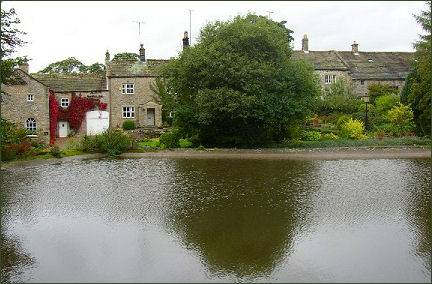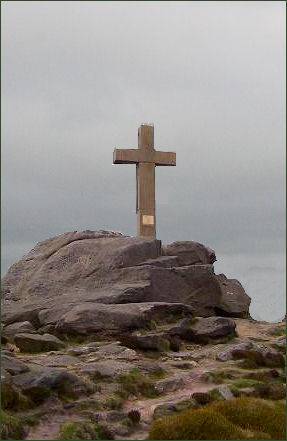Rylstone
OS grid reference:-
 The characterful village of Rylstone is situated around 6 miles to the south west of Grassington and 7 miles to the north of the town of Skipton. It lies within the stunning scenery of the Yorkshire Dales National Park. The village stands beneath Barden Fell, a large expanse of heather moorland and the highest point of Barden Moor, with its twin prominent landmarks of the Rylstone Cross (pictured right)and Cracoe Pinnacle.
The characterful village of Rylstone is situated around 6 miles to the south west of Grassington and 7 miles to the north of the town of Skipton. It lies within the stunning scenery of the Yorkshire Dales National Park. The village stands beneath Barden Fell, a large expanse of heather moorland and the highest point of Barden Moor, with its twin prominent landmarks of the Rylstone Cross (pictured right)and Cracoe Pinnacle.
 The village 's main claim to fame is that it was the inspiration of Lakeland poet William Wordworth's long narrative poem 'The White Doe of Rylstone' otherwise known as 'The Fate of the Nortons', which combines historical and legendary subject-matter. Wordsworth composed the poem in 1808 but it was not published until 1815.
The village 's main claim to fame is that it was the inspiration of Lakeland poet William Wordworth's long narrative poem 'The White Doe of Rylstone' otherwise known as 'The Fate of the Nortons', which combines historical and legendary subject-matter. Wordsworth composed the poem in 1808 but it was not published until 1815.
The White Doe of Rylstone is set during the Revolt of the Northern Earls, a failed uprising during the reign of Queen Elizabeth I, which occured between 1569 and 1570, when the northern catholic nobility led by Charles Neville, 6th Earl of Westmorland, and Thomas Percy, 7th Earl of Northumberland, attempted to depose the queen and replace her with her Catholic cousin, Mary Queen of Scots. The poem recounts the legend of the White Doe which it is related made a weekly journey from Rylstone Hall, the home of the Norton family, across the fells to Bolton Abbey to visit the grave of the Norton's only daughter Emily.
In the sixteenth century, Richard Norton, of Rylstone Hall founded a fortified stone watch tower or hunting lodge at Rylstone. The tower stands against a ridge and is defended on the east side by the remains of a ditch and a stone wall. In the remaining walls of the square tower, are a spiral stair, a fireplace and on the south wall, a drawbar slot defended by a fore building, which locates the original entrance. The tower was slighted in 1569, after the involvement of Richard Norton and his nine sons, in the Rising of the North.
A more recent claim to fame derives from the fact that a number of ladies from the vilage along with some from nearby Cracoe were the inspiration for the Helen Mirren movie Calendar Girls. During the late 1990s members of the local Woman's Institute decided to raise money for leukaemia research by producing a tasteful nude calendar. To the surprise of those involved, the calendar sold more than 200,000 copies.
The village church of St Peter's is located along a trackway at the eastern side of the village, was built in 1852-53 to a design by the Lancaster architect E. G. Paley, it replaced an earlier church on the site. The interior contains fragments of an Anglo-Saxon cross and another Pre-Conquest stone. Some carved fragments in the porch are believed to be part of an Anglo-Saxon cross, while embedded into the vestry wall a round-shaped stone decorated with cablework and circles which may possibly be of Viking origin.
The Rylstone Cross stands high on Barden Fell. The hill was once crowned by a stone figure known as the 'Rylstone Man', but it was changed to a wooden crucifix to commemorate the 'Peace of Paris' in 1885. In the decades that followed it had to be replaced several times until the wooden structure was changed to a stone one in 1997.
Towns and Villages of Yorkshire
